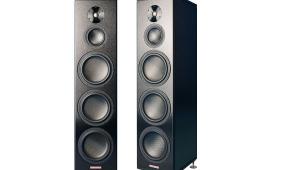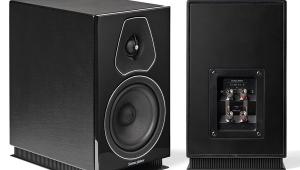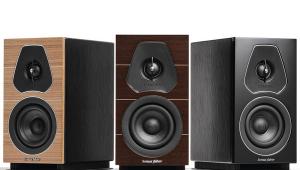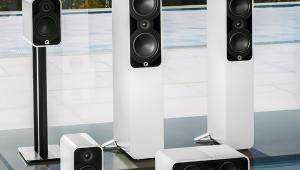KEF Blade - £20,000
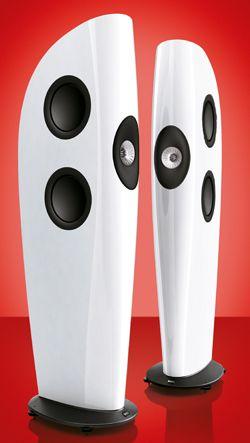
KEF has been virtually synonymous with loudspeaker innovation for five decades. Although in recent years the company’s main preoccupation seems to have been with multichannelhome cinema, through an impressive succession of clever designs, but the Blade looks likely to put KEF back on the stereo hi-fi top table.
Conceived by Mark Dodd and executed with considerable assistance from Jack Oclee-Brown, a Project Blade ‘technology demonstrator’ first appeared two years ago. There was talk of it going into production, but nothing had been decided and its elaborate and costly enclosure – a carbon fibre,balsa wood sandwich – meant that the price was likely to be something like twice our review speaker’s £20,000 price.
The Production BladeThat’s still expensive, no question,but it’s a sum which no longer seems unduly extravagant in today’s highend context. And what you get is arguably the most stylish speaker on the planet, thanks in part to industrial designer Eric Chan of ECCO Design, as well as one of the most advanced in engineering terms.
Now fabricated in moulded fibreglass, the Blade looks very similar to the prototype and is no shrinking violet. It stands more than 1.6 metres tall and also needs to be sited well clear of walls, so it will certainly be a dominant feature in any normal domestic environment. Looking wonderfully slim from the front with a moulded enclosure formed into a continuous series of curves, the profile does indeed somewhat resemble a machete, but it’s also rather reminiscent of the wing of a Spitfi re, with the frontmounted Uni-Q driver representing the cannon. The body proper is then supported on an equally elegant plinth, dough-moulded in a mineraland metal-loaded resin to provide good mass and footprint stability.
KEF’s co-axial Uni-Q driver seems to have been with us since time immemorial, but the variation used here is very different from its predecessors. While it still adopts the classic technique of positioning a tweeter powered by a compact neodymium magnet on the central pole of the midrange driver, much work has gone into maintaining a consistent acoustic wavefront transition between tweeter and midrange and thence to its mounting in the enclosure.
The tweeter’s titanium-alloy dome uses a two-part construction to improve rigidity and achieve a wide bandwidth, and loads the diaphragm with short horn and a ‘tangerine’ waveguide in order to deliver a spherical wavefront. The midrange driver is even more radical. The flared diaphragm is constructed on a skeletal substrate, moulded in liquid-crystal polymer, faced by a ribbed diaphragm in a lithium/magnesium/aluminium alloy. It has an outside diameter of 95mm and an inside diameter of 47mm, so it’s actually an annulus in shape to maintain the spherical wavefront, alongside a minimal and fl at surround. It has a large 75mm voice coil, driving the diaphragm atits first bending node and ensuring massive power handling reserves.
The mid/treble Uni-Q is mounted in a small sub-enclosure that is mechanically decoupled from the main enclosure and acoustically integrated via a carefully shaped rubberised trim pad. Not to be outdone, the bass is equally radical. It uses four 230mm drivers with shallow-dish 175mm alloy diaphragms (roughly equivalent to one 17-incher), mounted on both sides immediately above and below the Uni-Q. The magnets are housed within large 115mm voice-coils that are deliberately decoupled from the diaphragms to limit the bandwidth,and the drivers are mounted in back-to-back pairs, so that their reaction forces cancel each other out – shades of KEF’s 104/2 from the mid-1980s. Besides plenty of reinforcing ribs, the enclosure is internally divided, so that each pair of bass drivers is reflex-loaded by half the total volume and a rear port.
Ensuring that the Blades are properly vertical is vital from an aesthetic point of view, so the little spirit level built into the plinth is very useful – as is the fact that the spikes are top-adjustable – and then locked by generous and accessible thumbwheels with serrated edges. Two terminal pairs permit bi-wiring or bi-amping, while a third terminal like pair acts as captive links.
The disposition of the drivers is designed to create a ‘Single Apparent Source’, which is clearly a good thing (though the press release’s claim that this is a ‘World’s First’ ignores the fact that Cabasse launched La Sphere back in 2007). Just as significant is the fact that all the drivers are designed to operate pistonically through (and well beyond) their operating ranges.
Stunning StereoCertainly the fi rst thing one notices on connecting up and playing the Blade is its stunning stereo imaging– tightly focused and precisely layered, with convincing depth perspectives and accurate lateral locations. It did at first seem a little strange, or at least unusual, to find all the sound emanating from a point source a metre off the ground, But if this is what a ‘single apparent source’ is able to do, then we ought to have a whole lot more of it.
Although the best image is inevitably available for those occupying a ‘hot seat’ equidistant from the two speakers, the Blade still gives a remarkably good image around and between the speakers. Furthermore, walk around the room and the character of the sound remains very consistent and stable, which is actually quite remarkable when compared to nearly all the competition.
The tonal balance is beautifully smooth, open, evenhanded and neutral, at least above the upper bass region. We did struggle a bit initially with the bass alignment and integration, but sorted that out by moving the speakers further out into the room and away from the wall behind than the ‘free space’ locations we normally use. The result was sonically very satisfactory, but somewhat inconvenient from a lifestyle perspective. The conclusion must be that the Blade is really a speaker that works best in a fairly large space – ideally one rather larger than our 4.3x2.3x5.5m room – or indeed one whose construction techniques involve rather more natural bass absorption.
Furthermore, the room layout should be such as to allow plenty of free space around the speakers. The exceptional stereo imaging along with refreshingly ‘open’ voicing are the first things one notices after connecting up these speakers, so much so that the bass end doesn’t immediately attract attention with most programming. It is, in fact, deep, powerful and well timed, but also almost uncannily free from any colorations and as such it’s easily overlooked until called upon to do the business. However, pick a favourite drum solo – one with plenty of kick drum action – and wind the volume up as high as it can go. Then walk up to the speakers (wearing ear defenders) and put your hand against the enclosure and notice how much vibration you can feel. That’s right – nothing! The power of force cancellation in avoiding any trace of cabinet coloration is truly remarkable.
Dynamic RangeDespite its considerable surface area, there’s no evidence of any enclosure coloration here, either as a result ofvibrations generated within the structure itself, or as an acoustic consequence of the shape of the front baffle. That is reflected in both an impressive freedom from any boxiness – or indeed any tendency for the image to cluster around the speakers – and in an exceptionally wide dynamic range, due to a freedom from low-level ‘hash’ The latter, in particular, gives exceptional results with classical material and choral performances, where the accurate rendition of low-level ambience plays a crucial part in creating an effective illusion.
The voicing of a loudspeaker through the critical presence region always involves a degree of personaljudgement and taste. The Blade certainly has a little more presence energy than average and, as a result,has a tendency to sound a little forward, even slightly aggressive with some recordings, especially if they’re played at a high level. However, across a broad range of different equipment, sources and material it simply sounds neutral, open and correct, with great coherence and freedom from strain.
If there is a bias towards a particular type of music, the Blade does seem particularly comfortable with classical material, where its ability to deliver convincing instrumental textures was easy to appreciate. But they’re also well able to rock as and when required, even though the midband, rather than the bass, takes the lead.
Sonic StatementThe Blade is very much a visual, as well as a sonic statement, and as such won’t appeal to everyone.But the bottom line is that this loudspeaker is a truly impressive technological achievement, stuffed with clever ideas that come together to deliver exceptional performance throughout the whole audio band.
While the stereo imaging is its most outstanding and obvious characteristic, it’s also always very informative and entertaining across the whole gamut of musical styles and genres, and works well with speech and movie soundtracks, too.
LIKE: Unboxy with wide dynamics and good imaging
DISLIKE: Can sound bright, lacks some bass authority and warmth
WE SAY: A stylish speaker with a wide dynamic range, but the bass can lack weight
PRODUCT:
KEF
ORIGIN:
UK
TYPE:
Three-way
floorstanding
loudspeaker
WEIGHT:
57.2kg
DIMENSIONS:
(WxHxD)
363x1,590x540mm
FEATURES:
• Uni-Q mid/
treble driver
• 25mm two-part
aluminium dome
tweeter with
tangerine waveguide
• 125mm midrange
driver with Li-Mg-Al/
LCP hybrid cone
• 4x225mm
force-cancelling
bass drivers
• Two rear-ported
bass chambers
• Tall, slim-moulded
fibreglass enclosure
• Finished in gloss
black or white,
plus a dozen
custom colours
• Moulded mineral/
metal-loaded plinth
for appearance
and stability
• Top-adjustable
spikes
• Built-in spirit level
aids set-up
• Twin terminal pairs
with captive links
DISTRIBUTOR:
KEF Audio
TELEPHONE:
01622 672261
WEBSITE:
kef.co.uk
 |
Inside this month's issue:
Q Acoustics 3020c standmount loudspeakers, Perlisten R10s active subwoofer, Quad 33 and 303 pre/power amps, Acoustic Solid Vintage Full Exclusive turntable, newcomer Fell Audio Fell Amp and Fell Disc and lots, lots more...
|









